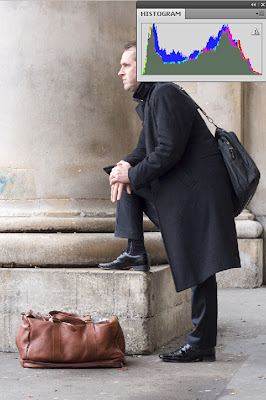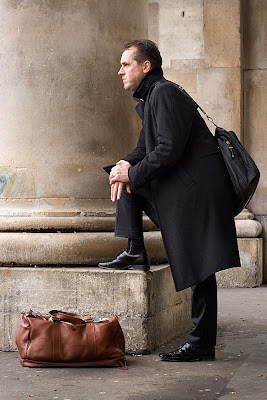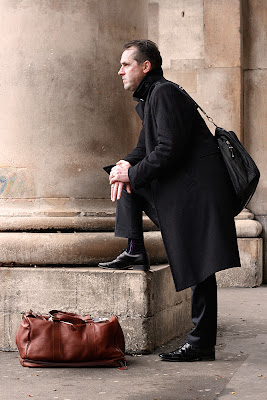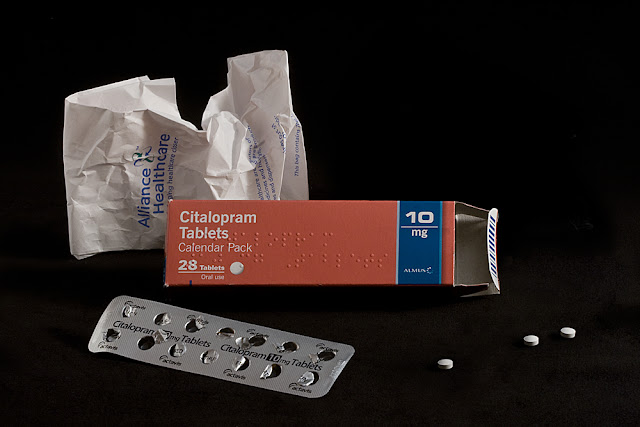Idea/Theme
Having thought of the still life theme and wanting to interpret that with concepts which affect everyone's lives I started to contemplate the ideals of Health, Wealth and Happiness. These are principles that we all aspire and relate to. Incorporating a personal connection with each image was another challenge; could I show where I have been, where I am, where am I going via photographs? How much of me did I want to reveal? I wanted my images to be honest so thought there should be no hiding, so my intentions were clear. I wanted to produce 6 images, within a theme, meeting the required lighting conditions, that I and others could connect with.
The Set Up
My dining room was turned into a make-shift studio which could be left undisturbed for an amount of time. I decided to light my subjects using an anglepoise lamp, based on the need for consistent lighting and not having to worry about the sun moving across the sky or disappearing behind clouds. However, having large windows and patio doors meant there would be mixed lighting conditions for each shot.
This challenge was overcome by pushing my table up against the window, draping my background material, black cotton velvet, over the existing curtain rail, which not only gave me an excellent backdrop but also acted as a black out curtain. The lamp was setup to the right hand side and a piece of large thick black card was placed opposite to cut out as much light as possible from the patio doors to the left. I also discovered that a certain time of day was better suited for shooting; as the sun moved round in late afternoon there was no longer reflected light bouncing off the cream walls. Each individual shot then had it's own challenge or adjustment.
Also wanting a consistent look to my series of shots I decided to use the same focal length for each and opted for my 100mm macro lens. I wasn't sure at first if I wanted the images to have a shallow depth of field or not and this lens would allow me to experiment. As I had created a situation which possibly needed the use of long exposure times plus the need to keep the camera still, I used my tripod and shutter release cable.
Workflow
Workflow followed was similar to that laid out in Assignment 1. Location/set up prepared in advance, equipment sorted, each subject was shot on average 20 times, experimentation with light and composition followed by initial editing, first selects, final selects and post processing.
Final Images
Image 1: Health
The World Health Organization estimates that approximately 450 million people throughout the world struggle with a mental health problem. Depression is a major category of mental health distress affecting people of every age, background and ethnicity.
Statistics show that 1 in 4 Britons will suffer from a mental health problem within a given year, with anxiety and depression being the most common combination of mental health disorders in the UK. Between 8 and 12 percent of the population will struggle with depression and the effects on home, career, relationships and personal esteem are enormous. I'm part of a statistic!
ISO 200 F25 @ 20 seconds.
Having quite a bright light and reflective white paper I chose ISO200, preferring a greater depth of field I shot several frames and settled on f25. The camera's metering gave the shutter speed of 20 seconds for correct exposure.
Having a black background and white paper this is a high dynamic range image. Being predominantly black the histogram had most values towards 0 but values were spread across the entire axis. To prevent strong light and harsh shadows a large bedsheet was placed in front of the lamp as an improvised softbox/diffuser. To avoid fall off and dark shadows on the left hand side I used an A4 ringbinder covered in silver foil to bounce light back and provide an even light. At one point light was also reflected back using white card but this filled all the shadows with light and took away the element of texture. Due to the anglepoise lamp having a tungsten bulb the subject would have had a strong yellow/orange cast, to negate this I opted to use the custom white balance setting, taking a photograph of a piece of white card, filling the viewfinder with the image and adding this to the Custom White Balance Setting. Minor adjustments were made within ACR to fine tune the white balance by using the white balance tool. Subsequent local minor adjustments were carried out using a curves layer in photoshop.
Image 2: Wealth

Single parents make up more than one third of UK households and tend to be on a low income. It is likely that more single parents will have to seek debt advice as the rise in every day expenses, such as food prices and fuel bills, means it will be very difficult to survive financially. It is estimated that the cost of raising a child from birth to the age of 21 is more than £180,000. I'm part of yet another statistic :o)
ISO 400 F22 @ 30 seconds.
Due to the piggy being highly reflective I had to change to angle of the light source and also move it further away from the sheet "diffuser". The light was still too harsh so another diffuser of tracing paper was added between the sheet and the subject. As this made a lower-lighting situation I increased the ISO to 400. These adjustments created a much more pleasing "glint" on the subject without blowing the highlights. The silver foil reflector was itself reflected in the piggy bank so I used a large sheet of white card instead. To obtain the correct WB and reduce the chance of a colour cast I created a custom white balance. In ACR I made a slight alteration to the tint and temperature sliders. Minor local adjustments were done via a curves layer in photoshop.
Image 3: Happiness

David Cameron said there was "more to life than money" and GDP figures did not show the whole picture on how the UK was faring, now he is in power, the Prime Minister is planning to gauge the nation's "general wellbeing" via a regular household survey drawn up by the Office for National Statistics. Liberal Democrat MP, Jo Swinson said: "This is a positive and forward-looking move by the Government, which will give us a much better idea of the health of UK society.Relying solely on GDP to track the nation's progress excludes many of the things that we all know to be important, but that can't be measured by money."
So what makes me happy? Sunshine, chocolate and a surprise bunch of flowers. I was given a bunch of roses and hung onto them until they had dried out and were well passed their prime. About to throw them out I decided to photograph one instead.
ISO 200 F18 15 seconds.
Not having reflective surfaces and wanting to light inside the tightly furled, dried bud I was able to increase the light and therefore used ISO 200 giving more detail, less grain and brighter colours. With no highlights this is a low dynamic range scene. Having taken several shots I eventually settled on the image obtained using F18 @ 15 seconds preferring the softer focus at the edges with the sharp bud in the centre. I used the silver reflector to light the left hand side. No adjustments were made in ACR but a curves layer was used in photoshop to make local adjustments and boost colour and density.
Image 4: Hobbies
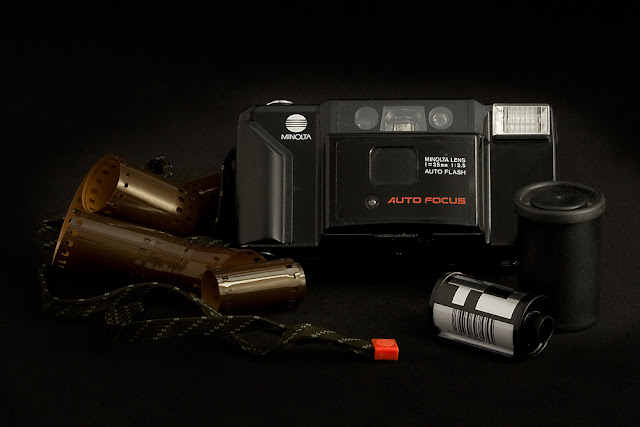
In January 2006 Konica Minolta Holdings announced its withdrawal from the camera and film businesses, marking the end to one of the best known brands in the photography world. As part of the surprise move, the Tokyo-based company said it would sell a portion of its digital single lens reflex camera assets to Sony.
The company said it would stop making photographic film and color paper by March 2007, pulling out of a market in rapid decline due to the spread of digital cameras, which store images digitally.
It’s the end of the road for Kodachrome film as the last processor recently announced that they would stop processing the slide film on 30 December 2010. Kodak first announced that they would stop making the film early in 2009, and now D-Day has arrived. Kodachrome film was first introduced in 1935 and was the first successful colour film made available on the market. The decision to stop producing the film was made as sales started to take a dip early last year, with Kodak announcing that the ‘film represents just a fraction of 1% of Kodak’s total sales of still-picture films’. This is due to the digital revolution which seems to dominate photography these days.Kodak stopped making film cameras in 2006.
I still have my Minolta lurking in the cupboard with my negatives...will I ever use it again? I doubt it. Will I keep it? Yes :o) Sad to think that I have contributed to the decline in film as I did love using it, but the versatility and cost effectiveness of digital is unrivalled.
ISO 800 F20 6 seconds.
Again wanting a sharp image from front to back f20 achieved this result, combined with ISO 800 a shutter speed of 6 seconds was required to obtain the correct exposure.This image presented interesting challenges. It was a dark subject which blended into the background and would require good lighting but was also reflective which could cause blown highlights if harshly lit. Being mainly black against a black background this is a low dynamic range image.
A solution was reached by reducing/diffusing the light and increasing the ISO to 800. The silver foil reflector once again created too many reflections in the film and a harsh reflected light on the left of the camera. This reflector was replaced with a softer white fabric.On close inspection there was a slightly yellow cast to the right and a blue to the left. As I was shooting earlier in the afternoon daylight was bleeding through over the top of my large sheet of black card. To help cut this light blankets were draped in front of the patio doors (they don't have curtains) and this showed a huge improvement. I used a custom white balance but uploaded images were still showing a slight cast. No adjustments were made in ACR as I couldn't fine tune it to my satisfaction, highlighting my need to improve my skills employing RAW conversion, however applying a black and white adjustment layer in photoshop to make local adjustments worked beautifully.
Image 5: Celebration
I have been trying to find the average cost of an 18th birthday celebration but nobody seems to have collated figures for this. However I did manage to find that the average cost of a wedding these days starts at £15,000.00? Wow.... I ask myself why? The last celebration I organised was in January for my daughter's 18th birthday and careful planning and shopping around kept the costs down. Everyone had a fantastic time and my pocket wasn't too dented.
ISO 200 F29 @ 25 seconds
Once more I did not want a shallow depth of field and F29 provided the effect I wanted. Reflectors and diffusers were used to create the soft light and shadows. With th ebright colours and lighting this is a mid range image. A curves layer was added in photoshop.
Image 6: Romance
The divorce rate fell by 2.5 per cent in 2008, the Office for National Statistics said. In 2007, out of 1,000 married people 11.8 got divorced, but this fell to 11.5 in 2008 – the lowest level since 1979. This is the fourth year in a row that the divorce rate has fallen. However, others warned that the figures gave a misleading picture.Claire Tyler, chief executive of Relate, pointed out that the data did not include figures on how many cohabiting parents separated. I'm part of the 2005 statistics ;o)
ISO 200 F29 10 seconds.
I thought this would be a low contrast image due to the majority of the tones being white/grey, although the values do stretch across the axis they are very low and there is a significant peak and bunching together of values towards the 255 end. But surprisingly it is more of a normal contrast image.
I employed a diffuser/reflector and a custom white balance. Slight adjustments were made in ACR to the exposure and temperature sliders. Further minor adjustments were made in photoshop via a curves layer and a B&W adjustment layer which was reduced in opacity and used to make local adjustments where I was still not entirely happy with the residual colour cast.
In Conclusion
I learnt a tremendous amount from carrying out this assignment. The use of diffusers and reflectors can greatly enhance the available light. This helped enormously with images of high and low contrast. If the opportunity is there to use a custom white balance I shall use it, as in the majority of cases it solved the issues with white balance/colour cast. Any residual problems were minor and easily resolved using ACR or photoshop.
From the outset I was aware that using my 100mm lens would compress the image and would probably have to use a minimum of f16 but it was surprising that I had to use up to f29 to achieve the depth of field for a pleasing result. Using a higher ISO also allowed me to capture images using low-light conditions. I would not go any higher than 800 due to the increased noise even though ACR does has the facility to adjust noise for both colour and luminance.
The black velvet fabric provided a seamless background and cut out the daylight really well. I did find out that bright/harsh lighting gave the velvet a grey appearance but the diffusers and experimenting with shutter speed/exposure corrected this problem. Another minor issue was with specks of dust/debris on the fabric which I did not notice at first but were clearly visible when viewing the images on my monitor. Images were either reshot after the velvet had been cleaned or specks were removed with the clone or healing tool.
After I converted the images to jpegs and altered the profiles to SRGB I noted that the subtle lighting and shadows tended to merge into the background. This gave the impression that the subjects were "floating". I have left the first images on my Blog to demonstrate this. On printing one of the images the loss of subtlety is not so bad but still not as good as I would have anticipated, therefore I reworked the Tiffs before uploading to my Flickr page for assessment. However it is interesting to note that the compressed jpeg images still aren't quite as accurate as I'd like which proves that you can't beat printing final images for display and that while some images can take compression and a reduction in size for display on the web others may need different processing to retain some of the original details.
On reflection I am quite pleased with the final set of images I have produced. They fulfil the brief given; a minimum of six images with varying lighting conditions applying knowledge gained over the course of the module. I also believe they met my own personal criteria of having a personal overtone which others will also connect with.




























